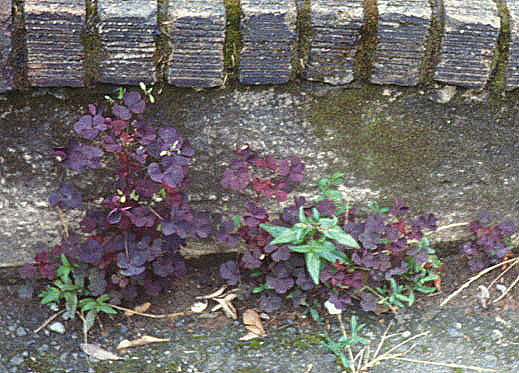
|
| Creeping Yellow Sorrel; Oxalis corniculata L. |
Wood Sorrel Family; OXALIDACEÆ
|
| Oxalis species, in general, are also called wood sorrels. Other names for this species are Lawn or Damn sorrel. Creeping Yellow
Sorrel is a cosmopolitan weed that originated in moist, tropical Asia, Malaysia, Australasia and the West Pacific. Creeping Yellow Sorrel, is
a highly variable cousin of Geraniums, not related to Sheep Sorrel although tasting similar. The most abundant of its forms is a
purple-tinged, low-growing herb with clover-like leaves and yellow flowers a quarter of an inch wide. The flowers give rise to seedpods less than an
inch long that ripen to spit forth the seeds. The plant is a small, taprooted perennial which also sends out creeping stems which root. |
| It is ubiquitous in nurseries and greenhouses. Yet unlike some weedy ferns that grow only in greenhouses, this sorrel is also
common outdoors in rockeries, poor lawns, street cracks, gravelly areas and ordinary garden sites. Being so adaptable, it thrives in most urban
sites. Deep shade alone seems to conquer the little demon. |
| Oxalis is an admittedly beautiful plant whether it is purple, bronze or green. The yellow flowers against purple leaves is
especially winsome. Nor does this little weed seriously bother plants (dainty rock-garden pets always excepted). But it is still a curse because of
its explosive reproductive tendency; it is too common to be tolerated. |
| The extermination of a well established population is almost impossible except by very careful approaches. Diligent, unfaltering
hand-control requires years. If the existing soil layer is quite full of
Oxalis seeds and plants, it can be replaced with or covered by a sterile
top-dressing or mulch. Poisons can be used, but have undesirable side-effects (they kill the good with the bad; and weeds can become
immune to them, etc.). |
When hand weeding, it is safe to compost the sorrels only after you have plucked from them their ripening seedpods. The
immature seedpods are tasty nibbles, but those with mature seeds are for the garbage.
|
Originally published as the Seattle Tilth newsletter Weed of the Month in February 1989, along with a photocopied plant.
Back |

